 Guthook’s PCT Guide – We used this app most frequently on the PCT. It cost $25 but was well worth it. The app was especially useful in the Sierra when the trail was under many feet of snow for miles upon miles. It works in airplane mode with the phone’s location service enabled which helps conserve battery life. We had this app loaded on Andy’s Samsung Galaxy S5 and were pleasantly surprised that it didn’t drain the battery too quickly.
Guthook’s PCT Guide – We used this app most frequently on the PCT. It cost $25 but was well worth it. The app was especially useful in the Sierra when the trail was under many feet of snow for miles upon miles. It works in airplane mode with the phone’s location service enabled which helps conserve battery life. We had this app loaded on Andy’s Samsung Galaxy S5 and were pleasantly surprised that it didn’t drain the battery too quickly.
Pros – great maps, uses Halfmile mileage, many more camping options than Halfmile, helpful descriptions and photos of campsites and water sources. There is an option to add real time descriptions and updates (the usefulness of this depends on the activity of the hikers in your class- particularly those ahead of you- but it is a great feature). If you get off trail you can see your location (love that blue dot!) on the map in relation to the trail.
Cons – It’s not free, but it contains A LOT more info than any of the free PCT apps. Some of the water sources are inaccurate – especially in Northern California or later in the season in the Sierra. A few water sources listed as reliable year-round were dry. There was one source off trail that didn’t even exist. I would trust Halfmile and the PCT water report for water. There are different user interfaces for iPhone and Android users. We only had this on a Samsung and cannot comment on the differences between the two platforms.
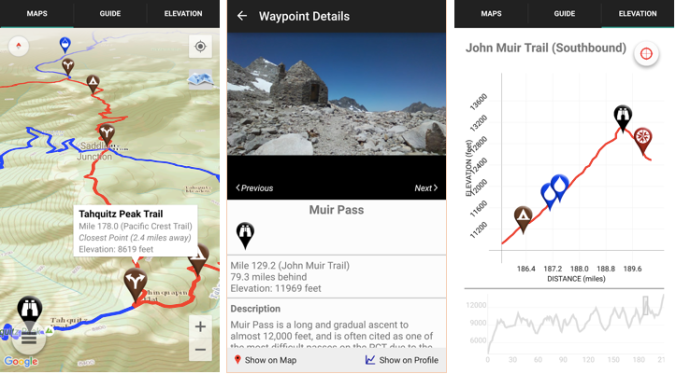
Guthook Android app detail
Halfmile – App is easy to use and very helpful. You can select a campsite or water source north or south of your current location and quickly get information on mileage and how much elevation gain and loss you will encounter before you get there. 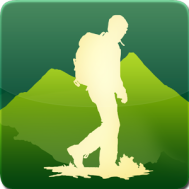
Pros – It’s free. Includes accurate data, is easy to use and has basic descriptions of water sources and other pertinent information. It is consistent with the information noted on the half mile printed maps. This app provides information on elevation gain and loss without having to add it up yourself (this is way too tedious and arduous after hiking all day!). When off trail (such as in the Sierra when the trail is covered in snow) the app will tell you how many feet you are away from the trail. This helps give you a sense (i.e. 50 ft vs 250 ft) as compared to Guthook which just shows your dot compared to the trail.
Cons – Few campsites listed. No pictures – just data. With Android phones, there is no map feature. On iPhones you see a map along with your location, but on Androids you see a dot (your location) and an arrow pointing to where the trail should be. Still useful but you get the sense the app was developed primarily for iPhones. When off the trail you have to simulate the trail mile. Often the closest PCT mile is not where you will be rejoining the trail so it takes a few more steps to get accurate information. This produced frustration in town when trying to plan for the next section.
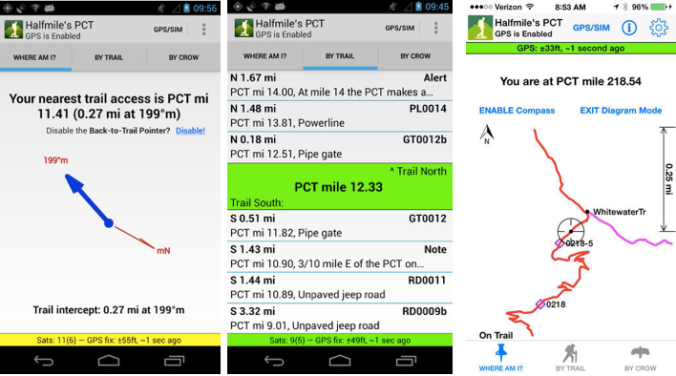
Left: Android map detail Middle: Distance – same for Android and iPhone Right: iPhone map detail
We liked having both Guthook and Halfmile for a more complete picture. We opted to have Guthook on Andy’s Android and Halfmile on Laurie’s iPhone. This worked well, as well as having Verizon on Andy’s phone and ATT on Laurie’s phone. This was a bonus of hiking together – we had more comprehensive cell coverage (more on hiking as a couple to come…)
**With both apps, or any others you plan to use for navigation, download them a week or two before your hike and get acquainted with them before you start hiking. It will make life on the trail easier**
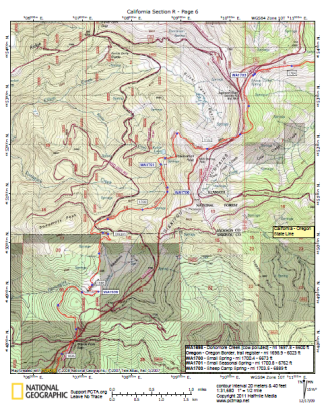 Halfmile Printed Maps – We liked having these maps but rarely used them. Map reading is an essential skill in the backcountry, but navigation by phone is here to stay. Because we were traveling together most of the trail, having two phones fail was unlikely. But if either of us were hiking solo, having the maps as a backup would have been more important. We would often look to the maps to see the names of the surrounding peaks but unfortunately the maps are PCT centric and don’t often include landmarks more than a few miles from the PCT. If you like to identify surrounding mountains, it may be helpful to carry a PCT section map (heavy but fun to look at) or a forest service map (helpful in Washington where the likelihood of fires increases and you may need to find an exit route).
Halfmile Printed Maps – We liked having these maps but rarely used them. Map reading is an essential skill in the backcountry, but navigation by phone is here to stay. Because we were traveling together most of the trail, having two phones fail was unlikely. But if either of us were hiking solo, having the maps as a backup would have been more important. We would often look to the maps to see the names of the surrounding peaks but unfortunately the maps are PCT centric and don’t often include landmarks more than a few miles from the PCT. If you like to identify surrounding mountains, it may be helpful to carry a PCT section map (heavy but fun to look at) or a forest service map (helpful in Washington where the likelihood of fires increases and you may need to find an exit route).
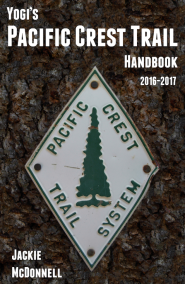 Yogi’s PCT Guideook – Andy liked reading other hiker’s accounts of their trail experience but didn’t care much for Yogi’s subjective dictation. “If you can afford to buy a beer in town you can afford to donate to trail angels. It’s the right thing to do.”
Yogi’s PCT Guideook – Andy liked reading other hiker’s accounts of their trail experience but didn’t care much for Yogi’s subjective dictation. “If you can afford to buy a beer in town you can afford to donate to trail angels. It’s the right thing to do.”
Sure some hikers need to read this, but Andy was turned off by this.
Yogi’s opinions aside, the town guides and trail notes are helpful, except for when they are out of date. Yogi has updates on her website but even some of those updates were inaccurate by the time we hit the trail. It wasn’t a big deal and I imagine it’s a heck of an undertaking to update every detail for every town or campground. Prices increase, businesses close. Things change in small town America. In short, don’t expect perfection with any guidebook or app.
If I had to do it over again, I wouldn’t buy Yogi’s book. The town maps were convenient but not worth buying the entire guidebook. Instead I’d use the following resources:
- As The Crow Flies
- Craig’s PCT Planner
- Boston and Cubby’s Trail Journal
- PCT-L
As The Crow Flies constantly updates her website with the latest information for the entire trail. This was my go-to resource.
Craig’s PCT Planner is a great tool for creating an itinerary for your hike. Things will undoubtedly change but having a plan in place can help keep you on track if you have to stick to a timeline. You can also use the planner to create multiple shorter itineraries. For example, you can create an itinerary for the first 300 miles averaging 17 miles per day, then create another one in which you average 20-25 per day for miles 301 to 702 (Kennedy Meadows).
Boston and Cubby share a great resupply strategy if you plan to ship yourself all (or most) of your packages. They also have a good gear strategy and gear review, along with a food strategy post.
The PCT-L is a great forum where people talk all things trail. There can be a lot of fluff to sort through but lots of good information is shared as well.
Lastly, the Facebook group(s) for the current year class are a great resource. Often times people who live in towns and are well connected with the trail will post pertinent information (changes to the Post Office hours for example) to the groups.
![]() Postagram – we loved this app. We used it to send postcards to friends and family whenever we had service. The app lets you write customized messages as well as a picture. The pictures are printed on perforated paper so they can be cut out and saved. Very cool app and a great surprise to anyone who doesn’t expect to hear from you for 6 months!
Postagram – we loved this app. We used it to send postcards to friends and family whenever we had service. The app lets you write customized messages as well as a picture. The pictures are printed on perforated paper so they can be cut out and saved. Very cool app and a great surprise to anyone who doesn’t expect to hear from you for 6 months!
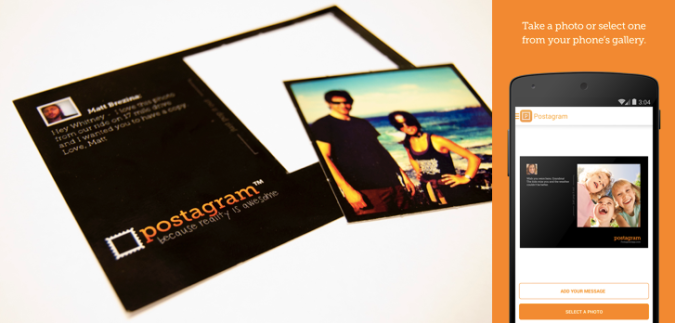
My husband and I are finding these posts so helpful as we plan for our 2018 thru hike! Thanks so much for all this info! ❤️
LikeLike
Kelly, we are happy to help. Please feel free to contact us with more specific questions as they come up. We are happy to share whatever knowledge we have.
LikeLike
Thank you..you are sending great info
Sent from my iPad
LikeLike
It is our pleasure. We hope some of it is helpful for your future adventures
LikeLike
Great info…Great read.
Tommy & Ali
LikeLike
Thanks Tommy & Ali!
LikeLike
Dear Shuffles and Dribbles,
Wow! Your latest email contains a BONANZA of great suggestions that sucked me right in. I’m supposed to be working right now, but…who wouldn’t rather read about trail life?
There are some resources in your email I hadn’t heard of, like As the Crow Flies and Postagram. Also, your review of Guthook kind of talked me into adding this app to the one I use, which is Halfmile.
Perhaps I really should go back to working right now, but I’m sure going to have a lot of fun reading and planning for next year as time off allows over this holiday season. Thanks so much! Hikers like you (and the author of As the Crow Flies and other resources) certainly help pave the way for those who walk in your path.
On another note, there’s a lot of snow in Central Oregon right now. Story and I have been enjoying shorter hikes using YakTrax or snowshoes. It’s usually either bright and sunny or snowing and festive, and either way, it’s lovely!
Thank you again for sharing.
Love,
Bright
LikeLike
Thanks so much Bright. We’re glad our review helped you! It’s always nice to have trips to look forward to, so I say plan away 🙂
Anyway, thanks sooo much for your card, we loved it! Happy playing in the snow, sounds magical.
LikeLike
LOVE this post ya’ll!!!! You guys rock. Thanks so much for taking the time to compile and share all your resources and experience.
LikeLike
Thanks Nikki!! Glad it helped 🙂
LikeLike